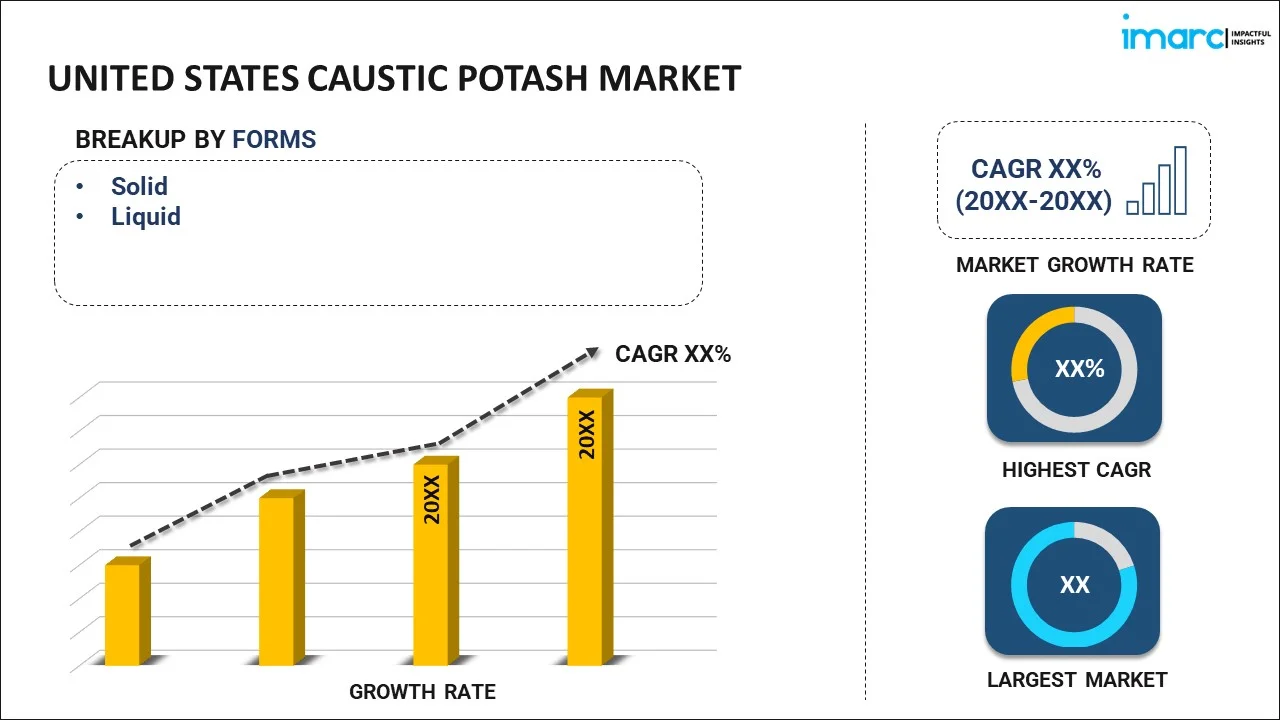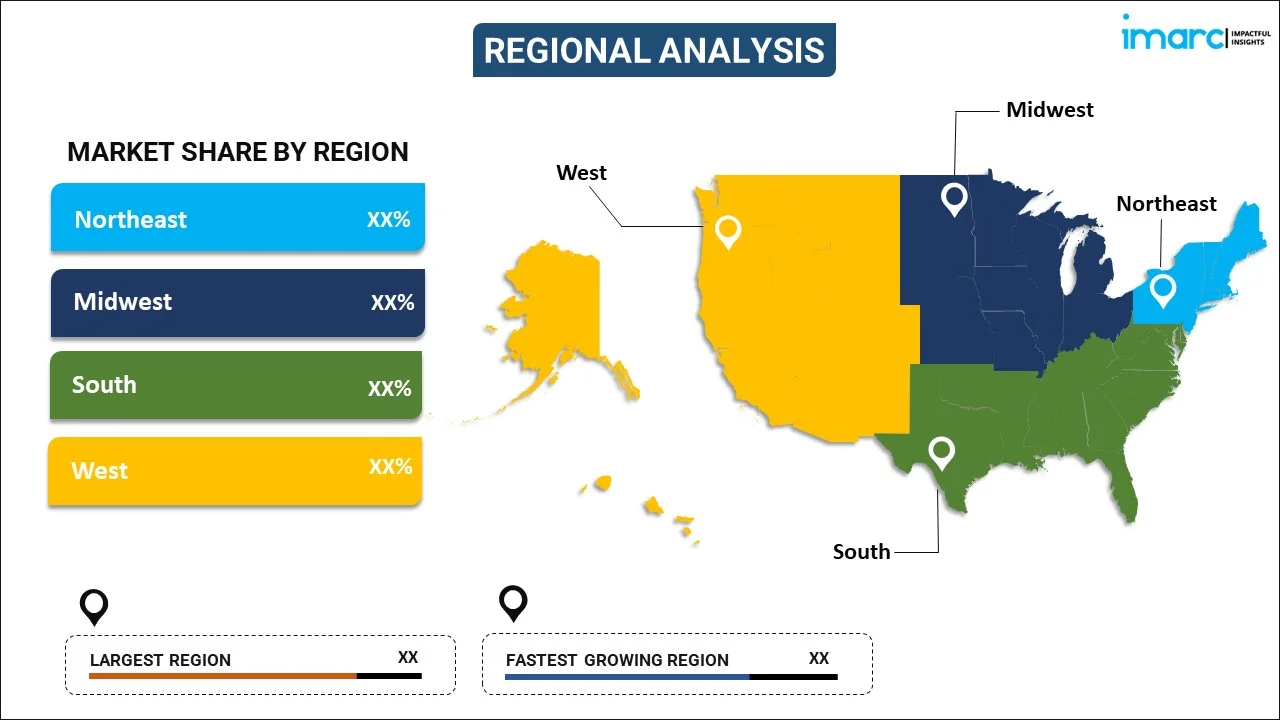
United States Caustic Potash Market Report by Form (Solid, Liquid), Grade (Industrial, Reagent, Pharma), End Use (Potassium Carbonate, Potassium Phosphates, Potassium Soaps and Detergents, Liquid Fertilizers, Agricultural Chemicals, and Others), and Region 2025-2033
Market Overview:
The United States caustic potash market size reached 650,990 Tons in 2024. Looking forward, IMARC Group expects the market to reach 791,220 Tons by 2033, exhibiting a growth rate (CAGR) of 2.13% during 2025-2033.
|
Report Attribute
|
Key Statistics
|
|---|---|
|
Base Year
|
2024
|
|
Forecast Years
|
2025-2033
|
|
Historical Years
|
2019-2024
|
|
Market Size in 2024
|
650,990 Tons |
|
Market Forecast in 2033
|
791,220 Tons |
| Market Growth Rate 2025-2033 | 2.13% |
Caustic potash or potassium hydroxide (KOH) refers to an inorganic alkaline compound made by the chemical process of electrolysis. It is an essential ingredient used for manufacturing various industrial chemicals like potassium chloride, acetates, cyanides, permanganates and citrates, along with phosphates, soaps and detergents, liquid fertilizers neutralization agents, and batteries. The compound is highly reactive and corrosive in nature, due to which it finds applications across many industries that rely on the strong chemical base with its ability to degrade materials.
The United States caustic potash market is primarily driven by the increasing consumption of processed and canned food products. Potassium bicarbonate, derived from caustic potash, is used as a major additive in the processed food industry. Caustic potash is also utilized as a de-icing agent due to the harsh and prolonged winter seasons across the United States. This generates a huge seasonal demand for caustic potash in the country. Besides this, it is used to manufacture various cleaning agents and as a sanitizer in wineries for cleaning the biofilms of bacteria and yeast inside the tanks. These applications of caustic potash in diverse end use sectors are providing a positive impact on the industry.
Key Market Segmentation:
IMARC Group provides an analysis of the key trends in each sub-segment of the United States caustic potash market report, along with forecasts at the country and regional level from 2025-2033. Our report has categorized the market based on form, grade and end use.
Breakup by Form:

- Solid
- Liquid
Breakup by Grade:
- Industrial
- Reagent
- Pharma
Breakup by End Use:
- Potassium Carbonate
- Potassium Phosphates
- Potassium Soaps and Detergents
- Liquid Fertilizers
- Agricultural Chemicals
- Others
Breakup by Region:

- Northeast
- Midwest
- South
- West
Competitive Landscape:
The competitive landscape of the industry has also been examined along with the profiles of the key players.
Report Coverage:
| Report Features | Details |
|---|---|
| Base Year of the Analysis | 2024 |
| Historical Period | 2019-2024 |
| Forecast Period | 2025-2033 |
| Units | ‘000 Tons |
| Scope of the Report | Exploration of Historical and Forecast Trends, Industry Catalysts and Challenges, Segment-Wise Historical and Predictive Market Assessment:
|
| Forms Covered | Solid, Liquid |
| Grades Covered | Industrial, Reagent, Pharma |
| End Uses Covered | Potassium Carbonate, Potassium Phosphates, Potassium Soaps and Detergents, Liquid Fertilizers, Agricultural Chemicals, Others |
| Regions Covered | Northeast, Midwest, South, West |
| Customization Scope | 10% Free Customization |
| Post-Sale Analyst Support | 10-12 Weeks |
| Delivery Format | PDF and Excel through Email (We can also provide the editable version of the report in PPT/Word format on special request) |
Key Questions Answered in This Report:
- How has the United States caustic potash market performed so far and how will it perform in the coming years?
- What has been the impact of COVID-19 on the United States caustic potash market?
- What are the key regional markets?
- What is the breakup of the market based on the form?
- What is the breakup of the market based on the grade?
- What is the breakup of the market based on the end use?
- What are the various stages in the value chain of the industry?
- What are the key driving factors and challenges in the industry?
- What is the structure of the United States caustic potash market and who are the key players?
- What is the degree of competition in the industry?
Need more help?
- Speak to our experienced analysts for insights on the current market scenarios.
- Include additional segments and countries to customize the report as per your requirement.
- Gain an unparalleled competitive advantage in your domain by understanding how to utilize the report and positively impacting your operations and revenue.
- For further assistance, please connect with our analysts.
 Inquire Before Buying
Inquire Before Buying
 Speak to an Analyst
Speak to an Analyst
 Request Brochure
Request Brochure
 Request Customization
Request Customization




.webp)




.webp)












